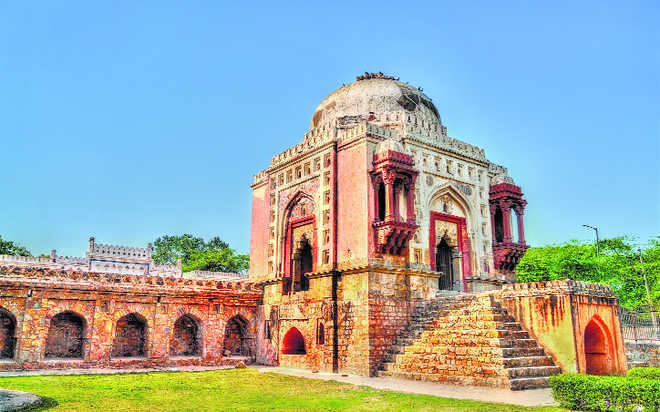
Madhi Mosque at the Mehrauli Archaeological Park in Delhi
Pankaj K Deo
Death and destruction are perhaps in the core of Delhi’s DNA, for it is situated on the bank of the Yamuna, which is called ‘Yami’ in Hindu mythology and happens to be the twin sister of Yama, the god of death. Yama and Yami are the divine binaries—Yama represents Death, whereas Yami represents life force. So, Delhi, like a phoenix, has the propensity to rise from the ashes, and history is witness that the city has risen from its ruins several times.
The culture, faith, and architecture of all those who came to the city from places afar got amalgamated into the city’s persona. Each dynasty that came to rule Delhi set up a new capital to distinguish itself from the previous ones. Rana Safvi’s sequel, The Forgotten Cities of Delhi brings to its readers the stories of the capitals that existed before New Delhi and their monuments—forts, tombs, dargahs—in her inimitable style. The narrative she builds around these monuments is laced with many asides and beautiful Urdu couplets that are telling comments on this hoary city’s past and present.
The age-old city today accommodates in its ambit the ruins and graves of its various rulers and prominent inhabitants over the centuries. And Safvi’s book is a treasure-trove of information on Delhi’s cities — the city of Mehrauli to the city of Shahjahanabad— and its denizens who once walked its terra firma with all the pomp and ceremony due to their social stature but now lie buried here, mostly forgotten. Many such personages from the past seem to strike a conversation with you when you peruse the pages bedecked with an eclectic range of couplets chosen carefully to describe the place and its history.
Every time a new city came up with the advent of a new ruler or a dynasty, it cannibalised the previous ones. Safvi writes: “When Emperor Sher Shah was building his city, Shergarh, much of the material for building was taken from Siri. Recycling was always in fashion.”
Safvi also brings into focus the paradisiacal imagery that underlies the architecture of Delhi monuments from Iltutmish’s tomb to the Taj Mahal, the Mughal masterpiece. She quotes art historian, Catherine Asher, in the preface: “A new theme was introduced in the inscription of Iltutmish’s tomb, one that became especially important for the Mughals, that is, eternal paradise as a reward for the true believer of the Day of Judgment.” Gardens were made as earthly replicas of a cosmographic model as conceived in Abrahamic religions—the garden at the beginning of time, such as Eden, and the Garden at the end of time that awaits the believer on the day of judgement.
Safvi elaborates, “While Sikandar Lodi’s tomb was the first garden-tomb to be built in India, it was Emperor Humayun’s tomb that went on to become a template, resulting in the Taj Mahal at Agra.” Gardens as enclosed arenas mark the sacred zone for the dead within a profane world. One may, however, say that the vision of Paradise as a central theme of architecture is evident even in the residential buildings of the Mughals. For, Diwan-i-Khas in the Red Fort in Delhi has the famous Persian couplet of Amir Khusrau inscribed on it: “If there be a paradise on the earth it is this, it is this, it is this.”
The dream of paradise seemed to be fading in the twilight phase of the Mughal dynasty as Mirza Ghalib who saw the end of the Mughal empire, wrote: “Hum ko maalum hai jannat ki haqiqat lekin, dil ke khush rakhne ko Ghalib ye khayal achchha hai” (We know the reality of the paradise, but Ghalib, the idea sounds good to keep the heart happy).
As you flip through the pages, Delhi’s best-kept secrets keep tumbling out about every nook and cranny of the city’s myriad monuments—from Suraj Kund and Kalka Devi Temple to Dadi Poti ka Gumbad in Hauz Khas to the tombs of Princess Jahanara and Raziya Sultan. One discovers that what we call Jor Bagh today was once Bagh-e-Jadd (garden of the ancestors) since it was a garden meant for the funerary buildings of the Lodis. The Safdarjung Tomb, another garden tomb, is also located near the Lodhi Gardens.
One comes to know that the area, where now the new Barapullah flyover stands, had a Mughal era bridge with 11 arches and 12 pillars. That the haunted place, Bhuli Bahtiyari ka Mahal, was a palace constructed by Bu Ali Bakhtiyari. The author had made innumerable trips to these monuments in the process of compiling information for this book.
She gathered many anecdotes during such journeys. One such anecdote is about the place called Jhandewalan. The place was named so because it used to host a fair in the Hindu month of Asadh (roughly June-July) where Brahmins would put their flagstaff or jhanda to conduct pavan parichha or wind testing to make weather forecast. In order to inspire the readers to find the places she describes, the author also provides a list of historical trails at the end, which history buffs can embark on in their free time. Overall, a wonderful book.



























